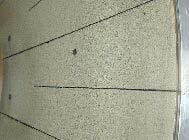Flat Honing and Lapping with Two-Wheel Machines
Machining Tools
Like any other tooling machine, these machines also need so-called tools and aids.

- Outer Drive
- Inner Drice
- Carriers
Figure 14: Basic Diagram with three carriers
The system with driven work-piece receivers (carriers) requires a suitable set for virtually every type of workpiece. The number of workpieces – usually between three and seven – and the work-piece exposure determine the diameter of the working wheels. A recommended rule states that approx. one-third of the workpiece surface should be exposed to the inner and outer diameter of the working plates. However, this depends to a great extent on the shape, the material, and the thickness of the workpieces. Thin workpieces and thin rings permit less exposure. Another criterion is also the thickness of the carriers, which must be custom for every type of workpiece.
Lapping Compounds
The lapping compounds for system and their use are more restricted for two-wheel lapping machines than for single-wheel lapping machines. At present, aluminum oxide, silicon carbide, boron carbide, or compounds in system are still being used. The carrier liquids vary from water to oil with specified viscosity. In the process, chemical additives require to guarantee the moistening of carriers of the grain (suspension behavior) and anti-rust protection. Oil-based liquids have more advantages because they dry out less and form a good grain film.
The water-based mixture ratio (powder to liquid) stands at 0.1-.02:1 or approx. 200-500g powder per liter of liquid.
The oil-based mixture ratio (powder to liquid) stands at 0.1-0.2:1 or approx. 100-200g powder per liter of liquid.
Additionally, the consumption for a single-wheel working wheel diameter of 750 mm is 4-5 L/hour on a water-based and to 2-3 L/hour on an oil basis. The consumption for two-wheel working wheels is approximately double.
Special gray cast iron, steel, nonferrous heavy metal or lightweight metal, fixed grains, and textile pads in various designs are used for the working wheels. The surface structure may be full, slotted, cross, or spiral grooved, depending on the type and use of the lapping compounds and of course the shape of the workpieces.
The lapping-compound mixture and supply to the working zone need a good pump system with constant mixing and precise metering. Experience has shown that a constant tank level is extremely useful for ensuring a regular feed. An additional tank with a cooling system and containing the volume for a day’s consumption guarantees regular daily production.
The used lapping compounds for system and of course the stock removal and the wheel wear must be disposed of the property. A powerful ring flush and shower are extremely useful. A fine-filter system is also worthwhile for large-scale consumers.
Flathoning tools
In summary, thanks to the use of fixed-grain wheels (flat honing), the level of dirt created are much lower. The fixed-grain wheels use a flood rinse, which carries the dirt into a filter system outside of the machine and makes the liquid reusable (clean lapping, figures 15, 16).

Figure 15: Full wheel design with grooves 
Figure 16: Pelleted wheel design
Here, one must differentiate between synthetically bound and ceramically bound wheels. Thanks to the relatively low cutting speeds of 1-25 m/s, it is possible to easily solve thermal machining problems such as the material type (plastics) and distortions of shape.
Figure 17: DLM 803 with cooling and filter system
(3 working wheels = 2 workstations)





